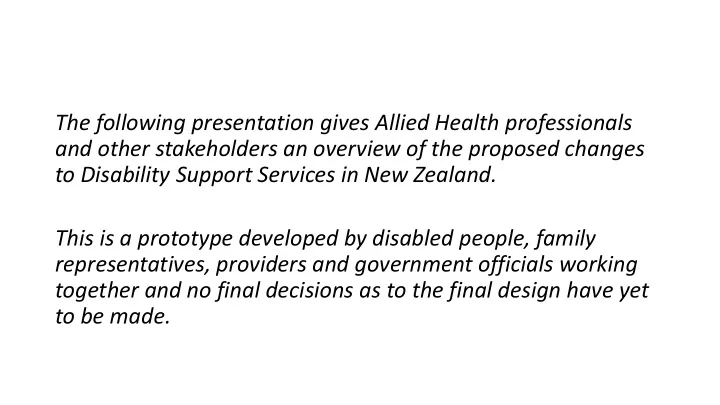

The following presentation gives Allied Health professionals and other stakeholders an overview of the proposed changes to Disability Support Services in New Zealand. This is a prototype developed by disabled people, family representatives, providers and government officials working together and no final decisions as to the final design have yet to be made.
System Transformation The transformation of New Zealand’s disability support system
Overview Case for change: why are we doing this? Background / what has happened so far? What does the new system look like? Looking more closely at environmental support services Questions / group discussion
Case for change Disabled people wanting more choice and control Current system - one size fits all Government funding fragmented Rising costs - $1.2 billion Poorer outcomes - education
Background Based on the Enabling Good Lives vision & principles Signals a shift towards the social model of disability Inverting the system – person centred Greater freedom over what and how to purchase support and equipment Rules still apply – but designed to support rather than restrict Focus on the whole solution Outcome focus
What has happened so far? • Feb – May 2017 Disabled people, family representatives, providers and government officials completed high level design • July 2017 Cabinet signed off the high level design • Aug – Dec 2017 Detailed design across 20+ working groups • 1/3 were disabled people • Jan – Mar 2018 Virtual testing groups – input into the various work streams • Mar 2018 Cabinet paper decision • Go ahead with prototype • Funding • Rollout across the rest of the country • October 2018 Prototype launch, MidCentral region • Test, learn and refine cycle for a year
Why MidCentral? People use Disability Support Services 1600 Māori population 20% City and rural Mix No No previous demonstrations trials Change Change readiness
What changes in the new system? Connector role Walk alongside people to help plan their lives Navigate the system Cross government funding Seamless support across agencies Transactional activities – behind the scenes Simple funding process Flexible use of funding and a range of ways to use it Outcomes Regional governance & capability building System responsiveness – learning, refining, changing Funding for capability & capacity building
Environmental Support Services (E (ESS) working group • We need to ask for information once and provide disability support information, at that time • Disabled people are included and make the decisions throughout the process • There are many choices and options available • People may be able to choose to get specialist services from private providers (but they do need to be approved providers) • The way people apply and get their funding is individualised • People can apply to purchase equipment and services in many ways e.g. using their personal budget, subsidies or their own money • People are encouraged to return equipment, if they no longer need it, so it can be used by other disabled people
Opportunities for ESS • Greater flexibility, fewer rules • Specialist support may still be needed • Shift in mindset to person-directed services • Balancing person-centred practice with the benefits of bulk purchasing • Equipment reissue versus flexibility and choice • One size does not fit all • Disabled people will be able to pick and choose from many options • Disabled people will have as much or as little involvement in the process as they want and will be able to change the mix of options as their lives change. • Taking an early investment approach to the application of ESS • should include all aspects of disability support and allow a disabled person to choose and combine supports in a manner that is appropriate for them • Focus on the assistive solution
Closing Comments • The change agenda has been led by disabled people and their family/whanau • It is not tinkering – this is genuine transformation • Less rules and bureaucracy for all • Still many unanswered questions – the devil will be in the detail
For r updates - http://www.enablinggoodlives.co.nz/ To contact the team – STfeedback@moh.govt.nz
Questions ?
Break out groups? Break into small groups Answer the following questions – spend 5 minutes on each: 1. How do you think person- directed ESS would be different to what we’ve got now? 2. How could the ESS planning process be improved? 3. How could we refine it for people?
Recommend
More recommend